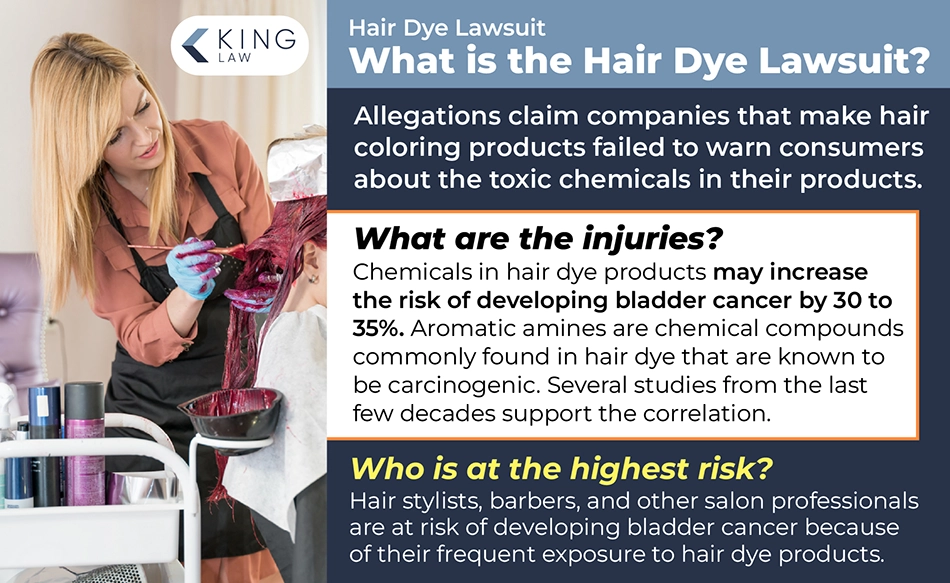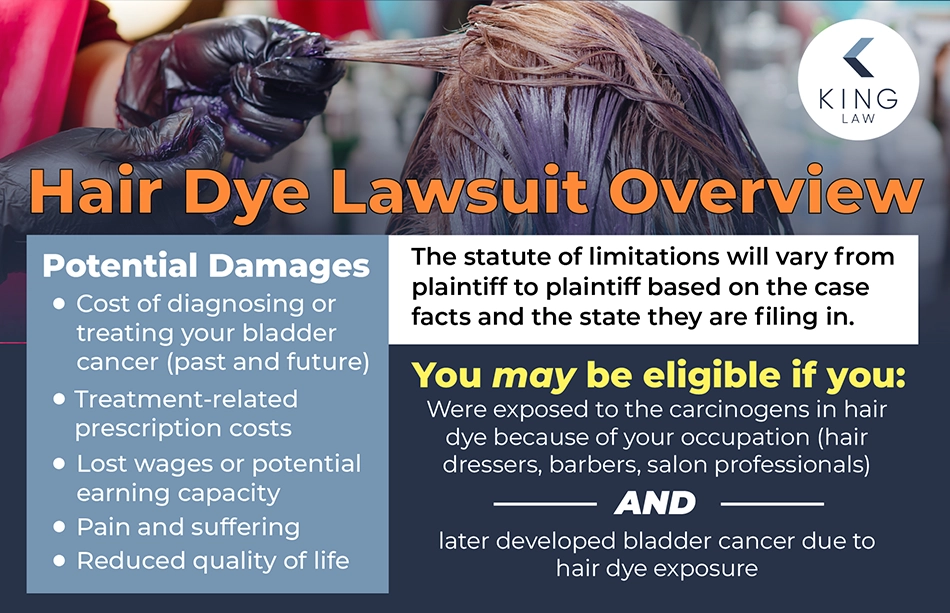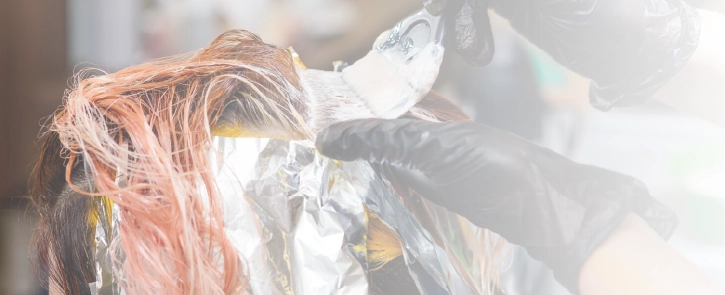
People are filing hair dye lawsuits alleging that cancer-causing agents in hair-coloring products caused their bladder cancer. These lawsuits accuse hair dye manufacturers, like L’Oréal, John Paul Mitchell, Clairol, and others, of not properly disclosing the potentially dangerous ingredients in their hair dyes. A recent study showed an increased risk of hairdressers developing bladder cancer, likely due to the presence of carcinogens like aromatic amines, which include 4-ABP and 4-aminobiphenyl.
Individuals who have developed bladder cancer after working with hair dyes in a hair salon say they were not properly warned about this dangerous side effect by beauty product manufacturers. After developing bladder cancer, many people suffered financial, physical, and mental setbacks. In an effort to gain compensation for these losses, people are filing hair dye lawsuits.
Hair Dye Lawsuit – July 2025 Updates
July 1, 2025: Bladder Cancer Surgeon Calls for Women to Stop Using Hair Dye
Dr. Raghunath is a bladder cancer surgeon at HCG Cancer Hospital. In a recent video, Dr. Raghunath explains that hair dyes contain chemicals that are damaging to the body. These chemicals are absorbed through the scalp and make their way to the kidneys and then the bladder. In his experience, these chemicals stay in the bladder for a long time and cause cancer to grow. Instead of covering up their gray hair, he encourages women to embrace it and protect their health.
June 18, 2025: 45-Year Nordic Study Shows Hairdressers Have Second-Highest Risk of Occupational Bladder Cancer
In 2009, researchers published a 45-year study that showed the rates of cancer among 15 million workers in Nordic countries. According to the results, hairdressers and chimney sweeps had the second-highest rates of bladder cancer compared to the rest of the occupational groups. The authors believed hairdressers were likely to get bladder cancer because they work in environments that are “rich in chemical agents.” Women who have developed bladder cancer after chronic exposure to hair dye have failed lawsuits against dye manufacturers for failing to warn them about the dangers.
June 3, 2025: New Jersey Cosmetologist Files Hair Dye Lawsuit After Bladder Cancer Diagnosis
Another woman harmed by hair dye has filed a lawsuit against manufacturers who exposed her to unsafe chemicals. Patrice Colamesta has sued L’Oréal, Clairol, Procter & Gamble, and other hair dye manufacturers. A resident of New Jersey, Patrice has been in the cosmetology field since 1972. She used hair dye to color her clients’ hair at least two to three times a day for five days a week, from 1972 until the present day. After her bladder cancer diagnosis, she sued to recover damages for her losses.
May 12, 2025: Another Hair Coloring Stylist Takes the Fight to Court After Receiving a Bladder Cancer Diagnosis
Beatrice Singleton, a licensed cosmetologist since 1987, has sued over a dozen manufacturers of hair coloring products. The Californian stylist claims the carcinogens in these products caused her bladder cancer. Beatrice said she worked from 1987 until her May 2022 cancer diagnosis, and she would dye hair about two to three times a day, five days a week throughout the entirety of her career. She has filed a hair dye lawsuit to pursue compensation for her injuries.
April 28, 2025: Virginia Hair Stylist Sues John Paul Mitchell and Other Beauty Companies Because of Bladder Cancer Diagnosis
Sharon Mirtaheri filed a lawsuit against John Paul Mitchell, Henkel, L’Oréal, Goldwell, and other beauty product companies that manufactured the hair dye she used. Sharon has worked as a hair stylist ever since she got her degree in 1975. After decades of exposure to hair color treatments, Sharon developed cancer that she believes was caused by the carcinogens in those treatments. She is suing for compensation for the cost of diagnosing and treating her cancer, as well as for her other financial, physical, and emotional losses.
March 6, 2025: Ex-Hairstylist Debra Matarazzo Sues Hair Dye Companies After Receiving Bladder Cancer Diagnosis
Hairstylist Debra Matarazzo of New Jersey filed a lawsuit against L’Oréal, Henkel Corporation, Wella Corporation, and Clairol, the makers of multiple hair dye products. Debra developed bladder cancer after working as a stylist in Brick, New Jersey, for 11 years. She would perform an estimated 75 to 100 hair color treatments each week, which unknowingly exposed her to carcinogens in hair dyes. After she received a bladder cancer diagnosis, she sued for compensation for her losses. She claims she was not adequately warned about the contaminants in the products she used every day during her shifts.
February 13, 2025: California Hairdresser Sues Because Hair Dye Ingredients Caused His Bladder Cancer
Hairdresser Hector Corvera sued L’Oréal and other beauty companies because the aromatic amines in the hair dyes he used on his customers caused his bladder cancer. When he received the diagnosis in 2023, he said, his doctor asked him what he did for a living and, when Hector said he was a hairdresser, his doctor said, “That explains it.” Research reveals that the ingredients or byproducts in hair dyes are known carcinogens, and companies have been aware of the risks of their products since the 1970s.
December 2009: Research Reveals that Hairdressers Are At a Higher Risk of Developing Bladder Cancer
An article published in the International Journal of Epidemiology disclosed that hairdressers have an increased risk of bladder cancer compared to workers in other fields and the public at large. The authors noted that this risk is likely due to the “potential carcinogens contained in hair dyes” that the workers are exposed to. Even so, many believe that hairdressers themselves were not adequately warned about this workplace hazard. Many did not discover the hair dye connection until they received their diagnosis years later.
September 2003: Studies Show Aromatic Amines in Hair Dye Linked to Bladder Cancer
A study revealed that aromatic amines in red, blonde, and black hair dyes are linked with an increased risk of bladder cancer. Previously, the American Cancer Society had identified 4-aminobiphenyl or 4-ABP as a known cancer-causing substance. However, it was not widely known that this substance was present in hair dyes. The carcinogen 4-ABP was not found in brown hair dye. Despite this knowledge, beauty companies did not include this risk on the labels of their hair coloring products.
About the Hair Dye Lawsuit:
What Is the Hair Dye Lawsuit About?
Does Hair Dye Cause Bladder Cancer?
Who Is Most At Risk of Developing Bladder Cancer From Hair Dye and Coloring?
Studies Link Hair Dye Ingredients to Cancer
Hair Dye Brands Named in the Bladder Cancer Lawsuit
Who Can File a Hair Dye Bladder Cancer Lawsuit?
Recoverable Damages in the Hair Dye Lawsuit
How to File a Hair Dye Bladder Cancer Lawsuit
Hair Dye Lawsuit Statute of Limitations
Average Settlements in a Hair Dye Bladder Cancer Lawsuit
King Law Is Accepting Hair Dye Cancer Cases
What Is the Hair Dye Lawsuit About?
The hair dye lawsuits allege that companies that manufacture hair-coloring products failed to warn beauty professionals about the toxins in their products. Many hair dyes contain known carcinogens, like the aromatic amine 4-aminobiphenyl. Repeated exposure to this substance at work has been linked to a higher chance of developing bladder cancer. Many beauty professionals breathed in these aromatic compounds, increasing their risk of developing bladder cancer.
Does Hair Dye Cause Bladder Cancer?
Many different studies support a connection between chemicals like 4-ABP and PPD and a higher chance of developing bladder cancer. For example, the International Agency for Research on Cancer identifies several chemicals in hair dyes as being probable carcinogens for humans. Long-term, heavy exposure through employment appears to carry the most risk, with one study finding that hairdressers are 30 to 35% more likely to develop bladder cancer than the general public.
What Chemical in Hair Dye Causes Cancer?
Several chemicals in hair coloring products can potentially cause cancer. These include aromatic amines, like para-phenylenediamine (PPD), 4-aminobiphenyl (4-ABP), 2-naphthylamine, and o-toluidine. These products are or were used to make permanent, semi-permanent, and temporary hair dyes. Some of these hair dye ingredients were banned in other countries or taken out of hair dyes because of the dangers to humans, including the danger of bladder cancer.
Aromatic amines are known to raise someone’s cancer risk, particularly if they work as a hairdresser. Even though there were known risks for those in the cosmetology field, beauty companies did not include proper warning labels on their hair dye products.
Who Is Most At Risk of Developing Bladder Cancer From Hair Dye and Coloring?
People who work in the cosmetology field and regularly encounter hair dyes have an elevated risk of developing bladder cancer. This includes hair stylists, salon workers, barbers, and cosmetologists. People in these professions may inhale the aromatic amines or other carcinogens or get the substance on their skin or under their nails, increasing their exposure.
Additionally, people who worked as hairdressers for 10 years or more had the highest risk of bladder cancer compared to casual users or those whose careers as hairdressers were less than 10 years. How someone’s body processes aromatic amines can increase their chances of developing bladder cancer, suggesting an epigenetic component.

Studies Link Hair Dye Ingredients to Cancer
Multiple studies dating back to the 1980s have investigated the connection between hair dye ingredients and bladder cancer. Researchers have consistently noted that exposure to hair dye ingredients through someone’s profession can have the most impact on their risk profile for bladder cancer.
Study #1: IARC Study on Hairdressers and Barbers
In 2010, the International Agency for Research on Cancer published research on how occupational exposure to hair dye ingredients can increase someone’s cancer risk. The chemicals the IARC rated as problematic include 4-aminobiphenyl, benzidine, o-toluidine, and 2-naphthylamine.
The IARC noted that hairdressers and barbers who work with aromatic amines and other hair dye chemicals have a higher rate of bladder cancer. The IARC went on to classify these substances as “probably carcinogenic to humans” for people who work as hairdressers and barbers. However, the IARC said casual consumers who have their hair dyed are at less of a risk of developing cancer from low level exposure.
Study #2: Use of Hair Dyes and Bladder-Cancer Risk
A 2001 study, “Use of permanent hair dyes and bladder-cancer risk,” found an alarming increase in bladder cancer rates among hairdressers and barbers. The researchers surveyed 1,514 women in Los Angeles who had bladder cancer. The control group included an equal number of women without bladder cancer. According to the results, people who work as hairdressers or barbers for 10 years or more were 5 times more likely to develop bladder cancer. Additionally, women who dyed their hair once a month were 2 to 3 times more likely to be diagnosed with bladder cancer.
Study #3: Bladder cancer among hairdressers: a meta-analysis
Bladder Cancer among hairdressers: a meta-analysis also directly addressed the question of whether hairdressers and barbers were more at risk of bladder cancer than others. The study, published in 2010, examined the bladder cancer rates among users and non-users of permanent hair dye and those who worked as a hairdresser.
The researchers confirmed that being a hairdresser or barber resulted in a “statistically significant risk” of bladder cancer compared to others. Additionally, the longer someone worked as a hairdresser, the higher the likelihood they would develop bladder cancer. Those who worked as a hairdresser for 10 years or more had the highest chances of developing this disease.

Hair Dye Brands Named in the Bladder Cancer Lawsuit
Hairdressers and barbers are suing a number of companies and brands, including:
- L’Oréal
- Henkel
- Clairol
- Wella
- Goldwell
- Schwarzkopf
- John Paul Mitchell
The people filing these lawsuits believe these companies were aware of the cancer-causing chemicals in the hair dye products they sold. They believe the companies did not have proper warnings on these products, putting hairdressers and barbers at an increased risk of developing bladder cancer.
Who Can File a Hair Dye Bladder Cancer Lawsuit?
People who were exposed to carcinogens in hair dye over a long period of time as part of their job may be eligible to file a lawsuit if they developed bladder cancer. These professions include:
- Hair stylists
- Barbers
- Salon professionals
The person must be able to show that they were exposed to hair dyes repeatedly in a work setting and developed bladder cancer afterward. At this time, consumers who used hair coloring products or had their hair dyed by a salon professional are not covered by the current hair dye lawsuit.

Evidence Needed to Support a Hair Dye Claim
Someone needs to have evidence to show that they were exposed to significant levels of hair dye and were diagnosed with bladder cancer because of it. Materials the person can use to support their claim include:
- Pay stubs from when they worked in a salon
- Affidavits (a written statement someone makes under oath)
- Medical records of their bladder cancer diagnosis
- Professional purchase records
- Tax documents from when they worked at a salon
The person would gather these or other supporting materials and, if applicable, include them in their complaint. These documents help the court know that they were exposed to hair dye with cancer-causing substances in it, have bladder cancer, and may qualify for compensation.
Recoverable Damages in the Hair Dye Lawsuit
If you win your hair dye cancer lawsuit, you may qualify for compensation related to your losses. For example, you could receive the following:
- The past and future cost of diagnosing or treating your bladder cancer
- Lost wages because of your bladder cancer
- Settlement to address the pain and suffering you experienced
Additionally, the at-fault company may have to pay punitive damages for failing to warn the public about the risk that someone may develop bladder cancer if they are exposed to hair dyes over a long period of time.
How to File a Hair Dye Bladder Cancer Lawsuit
If you think that being exposed to hair dye as part of your job is the reason you have bladder cancer, you may qualify for compensation. Here are the six steps to pursuing a hair dye lawsuit:
- Contact an attorney to discuss and confirm your eligibility to file a lawsuit.
- Gather documentation to support your claim.
- Your attorney prepares a legal complaint and files it with the court.
- Your attorney exchanges information (such as evidence) with the at-fault hair dye companies.
- Your lawyer has settlement talks to reach an agreement without going to trial.
- If a settlement cannot be negotiated, your case will go to trial and be decided by a jury.
King Law has vast experience helping people navigate the process of suing large companies like L’Oréal, Paul Mitchell, Henkel, and Clairol. We stand firmly behind the professionals who were exposed to cancer-causing chemicals without fair warning.
Hair Dye Lawsuit Statute of Limitations
People only have a limited amount of time to file a hair dye claim. If you believe chemicals in the hair dye you used at work caused your or your deceased loved one’s bladder cancer, you need to file within the statute of limitations. That deadline depends on the state law that applies to the person’s case.
Additionally, another factor that can impact the due date includes the timing of the diagnosis and when the person realized or should have realized their hair dye exposure caused it. Likewise, wrongful death claims have a different deadline than for a personal injury lawsuit. A seasoned attorney can assist the claimant with determining if they have a right to sue and, if so, when their filing deadline expires.
Average Settlements in a Hair Dye Bladder Cancer Lawsuit
The exact amount someone receives as a settlement if they develop bladder cancer because of their professional usage of hair dye products depends on a number of factors. For example, someone who develops severe or terminal bladder cancer may receive a higher payout. Our law firm estimates that some successful claimants may receive up to $50,000 to $250,000 if the judge or jury rules in their favor.
King Law Is Accepting Hair Dye Cancer Cases
King Law provides free case evaluations for people who believe they developed bladder cancer because of the chemicals in the hair dyes they used during their careers. We can review your employment history, medical records, receipts, hair dye product information, and other documents to understand if you can file a claim. We do not charge our clients any legal fees upfront to handle their claims. Instead, we only receive payment if we win a settlement or payout for you.
Contact a Hair Dye Bladder Cancer Lawyer Today
Hairdressers and barbers may have been unknowingly exposed to cancer-causing chemicals in the products they used to help their patrons color their hair. If you were a hairdresser or barber and developed bladder cancer, you may be eligible for a settlement.
Reach out to King Law today for a free case evaluation. Call us at (585) 496-2648 to talk to our dedicated intake specialists who can answer some of your questions and schedule an appointment with a seasoned personal injury lawyer. We are ready to fight for you and stand up against the injustice you have experienced because beauty companies misled you about the risks of their products.

